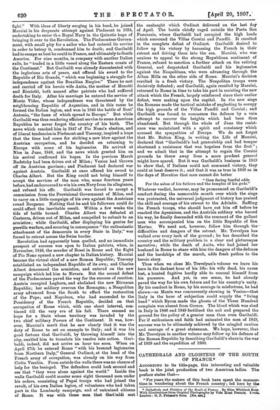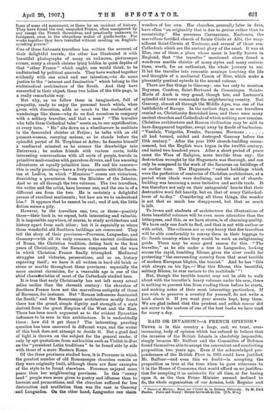CATHEDRALS AND CLOISTERS OF THE SOUTH OF FRANCE.*
ACCORDING to its title-page, this interesting and valuable book is the joint production of two American ladies. The preface states that—
"For years the makers of this book have spent the summer- time in wandering about the French country ; led here by the
• Cathedrals and Cloiotors of the South of Francs. By Elias Whitlock Rose. With Illustration!, from Original Photographs by Vida Hunt Francis. I vola.. London 0. P. Putiumes Bons. Ms. ask)
fame of some old monument, or there by an incident of history. They have found the real, unspoiled Franco, often unexplored by any except the French themselves, and practically unknown to foreigners, even to the ubiquitous maker of guide-books. For weeks together they have travelled without meeting an English- speaking person."
One of these fortunate travellers has written the account of their delightful travels; the other has illustrated it with beautiful photographs of many an unknown, picturesque corner, many a church cloister lying hidden in quiet depths of that "other France" which ought, one would think, to be undisturbed by political quarrels. They have worked together evidently with one mind and one intention,—to do some justice to the "interest and fascination" which belong to the ecclesiastical architecture of the South. And they have succeeded in their object, these two ladies of the title-page, in a really remarkable way.
But why, as we follow them in imagination, full of sympathy, ready to enjoy the personal touch which, when given with discretion, adds so much to the realisation of wanderings like these—why do we find ourselves in company with a solitary traveller, and that a man P "The traveller who tells these Cathedral tales" meets us, to our mystification, at every turn. "He" sits down on a wheelbarrow to meditate in the desecrated cloister at Frejus; be talks with an old peasant-woman, carrying melons, as he stands before the splendid portal of St. Trophime at Arles ; he fancies himself a mediaeval minstrel as he crosses the drawbridge into Entrevaux ; he makes friends with various cures, holds interesting conversations with all sorts of people, travels in primitive mail-coaches with garrulous drivers, and has amusing adventures at equally primitive inns. He and his camera— this is really puzzling—have a lively encounter with the Sacris- tan at Lodeve, in which " Monsieur " comes out victorious, flourishing a permission from the Minister of the Interior. And so on all through the two volumes. The two travellers, the writer and the artist, have become one, and the one is of a different sex from the two. He is certainly a delightful person of excellent sentiments ; but how are we to understand him P It appears that he cannot be real; and if not, the little fiction seems a pity.
However, be the travellers one, two, or three—possibly three—their book is, we repeat, both interesting and valuable. It is impossible anywhere, of course, to study architecture and history apart from each other ; but it is especially so where these wonderful old Southern buildings are concerned. They tell the story of their provinces—Provence, Languedoc, and Gascony—with all its early romance, the ancient civilisation of Rome, the Christian tradition, dating back to the first years of Christianity, the Saracen conquests and the wars in which Christian France finally triumphed. Mediaeval struggles and victories, persecutions, and so on, history repeating itself ; we have it all written in hard old brick or stone or marble throughout these provinces : especially the more ancient chronicles, for a venerable age is one of the chief charaCteristics of most of the Cathedrals studied here.
It is true that early Christianity has not left many actual relics earlier than the eleventh century : the churches of Southern France have not -the marvellous antiquity of those of Ravenna, for instance. But "Roman influences dominated the South," and the Romanesque architecture mostly found there has the grand, simple dignity and strength of a style derived from the great Empires of the West and the East. There has been much argument as to the evident Byzantine influence to be seen in this architecture. It is undoubtedly there how did it get there P The interesting, puzzling question has been answered in different ways, and the writer of this book does not attempt to decide it. But a good deal of light is thrown on the subject for the general reader, if only by apt quotations from authorities such as Viollet-le-Duc on the "persistent Latin traditions" to be found side by side with those of a more Eastern Rome.
• Of the thme provinces studied here, it is Provence in which the greatest number of old Romanesque churches remain as they were originally built, although there are finer examples of the style to be found elsewhere. Provence enjoyed more peace than her neighbouring provinces. In this "sunny land" people were more given to poetry and idleness than to heresies and persecutions, and the churches suffered far less destruction and mutilation than was the case in Gascony rand Languedoc. On the other hand, Languedoc can claim wonders of her own. Her churches, generally later in date, have often "an originality that is due to genius rather than to eccentricity." She possesses Carcassonne, Narbonne, the marvellous fortified church of Sainte Cecile at Albi, the 'nag,- nificent Saint-Cernin at Toulouse, and several of those sea- Cathedrals which are the ancient glory of the coast. It was at Elne, one of these, a place whose name is hardly known in England, that "the traveller" mentioned above found a. wondrous marble cloister of many styles and many restora- tions, worth, for an enthusiast, the whole journey to see. It led the traveller into romantic musings touching the life and thoughts of a mediaeval Canon of Elne, which make a pleasantly poetical episode in the second volume.
There are fine things in Gascony ; one has only to mention Bayonne, Condom, Saint-Bertrand de Comminges. Sainte- Marie of Auch is very grand, though late, and Lectoure's splendid old tower commands the neighbouring country. But Gascony, almost all through the Middle Ages, was one of the battlefields of Europe. In the earliest days, as our travellers remind us, Christianity flourished here, and there were many ancient churches and Cathedrals of which nothing now remains. Christian architecture and Roman civilisation may be said to have disappeared together, swept away by floods of barbarism
" Vandals, Visigoths, Franks, Saracens, Normans all had burned, raided and destroyed Gascony before the 11th century." After the year 1000 church-building recom- menced, but the English wars began in the twelfth century, and lasted two hundred years. After a short period of peace came the Wars of Religion, more terrible than any ; the destruction wrought by the Huguenots was thorough, and can only be compared to the work of the Saracens on buildings of an earlier time. The Huguenots "ruined buildings which were the perfection of centuries of Christian architecture, at a period when ideals were declining, and the art of church- building was becoming a mere imitative and servile trade. It was therefore not only on their antagonists' hearts that their destructive work fell heavily, but on that of every Cathedral. lover of to-day." Considering all these things, the wonder is not that so much has disappeared, but that so much is left.
To lovers and students of architecture the illustrations of these beautiful volumes will be even more attractive than the letterpress, and this, as we have shown, is of charming quality. We have only one fault to find, and that is not with author or with artist. The volumes are so very heavy that few travellers will be able comfortably to convey them in their luggage to tho South country where they would be such an enlightening guide. There may be some good reason for this. "The traveller," as he sits under a tree in Languedoc, looking across the rapid, tumbling Rhone, gives the river credit for protecting "the surrounding country from that most terrible of modern European blights, the tourist." And he has "this wish always on his lips,—' May this Rhone, this beautiful, solitary Rhone, be ever caviare to the multitude ' "!
But, though the terrible tourist may not be able to walk about with the traveller's heavy volumes under his arm, there is nothing to prevent him from reading them before he starts, and making notes of their most interesting particulars. If you wish to preserve a country for yourself, do not write a book about it. If you want your secrets kept, keep them. We are glad indeed that this prudent and selfish course did not occur to the makers of one of the beat books we have read for many a day.











































 Previous page
Previous page